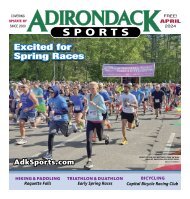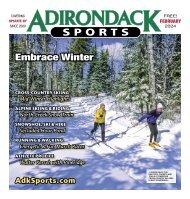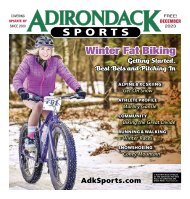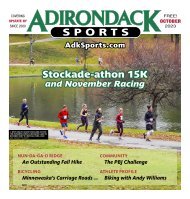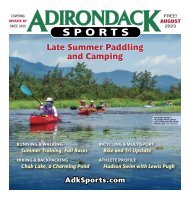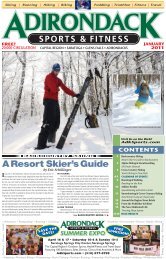Adirondack Sports November 2023
In this issue: 5 NEWS BRIEFS 7 WINTER SPORTS: Adirondack Sports & Northeast Ski Expo 11 RUNNING & WALKING: Turkey Trots - Fly Away Home with the Turkeys 15 ALPINE SKIING & SNOWBOARDING: Start Training for the Slopes 17 NON-MEDICATED LIFE: Potential Benefits of Advanced Cholesterol Testing, Part One 19 COMMUNITY: Buck 50 - An Epic Trail Race is Born 20 ATHLETE PROFILE: Kathy Meany: A Life of Service 23-29 CALENDAR OF EVENTS: A Bounty of Fall and Winter Things to Do 31-39 RACE RESULTS: Top Early Fall Finishers
In this issue:
5 NEWS BRIEFS
7 WINTER SPORTS: Adirondack Sports & Northeast Ski Expo
11 RUNNING & WALKING: Turkey Trots - Fly Away Home with the Turkeys
15 ALPINE SKIING & SNOWBOARDING: Start Training for the Slopes
17 NON-MEDICATED LIFE: Potential Benefits of Advanced Cholesterol Testing, Part One
19 COMMUNITY: Buck 50 - An Epic Trail Race is Born
20 ATHLETE PROFILE: Kathy Meany: A Life of Service
23-29 CALENDAR OF EVENTS: A Bounty of Fall and Winter Things to Do
31-39 RACE RESULTS: Top Early Fall Finishers
Create successful ePaper yourself
Turn your PDF publications into a flip-book with our unique Google optimized e-Paper software.
NOVEMBER <strong>2023</strong> 15<br />
ALPINE SKIING & SNOWBOARDING<br />
Start Training<br />
for the Slopes<br />
WHITEFACE MOUNTAIN<br />
GORE MOUNTAIN<br />
By Mona Kulkarni Caron<br />
Enjoy the resorts this winter by<br />
training now and staying injury-free.<br />
You can protect yourself<br />
from getting hurt by building strength<br />
and improving your flexibility and balance.<br />
Strength in your legs, hips and core<br />
are the best preventive measures to help<br />
avoid injury and now is the time to get<br />
started before the season begins. If you’re<br />
a fit cyclist or runner, you may have a<br />
head start.<br />
Alpine skiing and snowboarding are<br />
terrific outdoor activities that can be<br />
enjoyed no matter what your skill level.<br />
Skiing injuries have dropped in the last<br />
half century, due to advances in equipment,<br />
protection and better trail maintenance.<br />
The things that make snow sports<br />
thrilling can also make them risky. In<br />
addition, shifts in weather, ice patches,<br />
and other skiers and riders.<br />
Several strategies can help prevent<br />
ski injuries, such as having appropriate<br />
equipment and choosing ski runs that<br />
match your ability. But for the best odds<br />
of staying safe, you need to build strength<br />
– especially in the legs, hips and core –<br />
before the season.<br />
The most common alpine skiing injuries<br />
are in the knees with a third of all<br />
involving anterior cruciate ligament or<br />
medial collateral ligament tears. Today’s<br />
stiff ski boots and quick-release bindings<br />
have led to a drop in tibia and ankle fractures,<br />
but this equipment has made skiing<br />
harder on the knees. Injuries to the shoulder,<br />
wrist and lower leg can also happen,<br />
as are thumb ligament tears, known as<br />
“skier’s thumb.” Twisting injuries like ACL<br />
tears are more common when snow is soft<br />
or deep. When snow is hard-packed or icy,<br />
fractures are more common.<br />
Snowboarders are more likely to<br />
see broken or sprained wrists, dislocated<br />
shoulders and collarbone fractures,<br />
from falling on an outstretched hand.<br />
Snowboarders may want to wear extra<br />
protection with wrist guards, tailbone and<br />
knee pads.<br />
In addition, beware of late-day fatigue.<br />
Many injuries occur at low speeds, on easy<br />
runs, at the end of the day when people are<br />
physically and mentally tired. You don’t<br />
see as many bad injuries on challenging<br />
trails because people there are often<br />
more focused. Use good judgement on the<br />
slopes, especially at the end of the day and<br />
don’t attempt the most difficult run after a<br />
long day of skiing or riding.<br />
According to the American Academy<br />
of Orthopaedic Surgeons, cold muscles<br />
are more prone to injury so warming up<br />
with jumping jacks, running or walking in<br />
place for a few minutes can help. Take a<br />
couple of slow ski runs to complete your<br />
warmup. Mild levels of dehydration can<br />
affect physical ability and endurance so<br />
drink plenty of water before, during, and<br />
after skiing.<br />
Strengthen the muscles most at risk<br />
as skiing requires a tremendous amount<br />
of leg strength. Hamstrings are the most<br />
important muscles for stabilizing your<br />
knees, and people with weak hamstrings<br />
and strong quadriceps are especially<br />
prone to ACL injury.<br />
Strength training can improve your<br />
odds of staying healthy considerably.<br />
The benefits go well beyond skiing, as<br />
improving your balance can lower risks<br />
of age-related injuries. Start training at<br />
least a month before your first run with<br />
a strengthening routine at least twice<br />
a week. Your body needs some time to<br />
actually adapt to the exercise and create<br />
muscle strength for a long day or half day<br />
of skiing or riding.<br />
If you’re looking for a beginner workout,<br />
start with a few warm-up exercises<br />
(credit: New York Times). If you’re not<br />
sure how to do them, do a quick internet<br />
search for instructional photos or videos.<br />
Do each one and then repeat once<br />
more. Single-Leg Glute Bridge (10 reps<br />
on each side); Inch Worm (five reps); Leg<br />
Out T-Spine Rotation (six reps on each<br />
side); and Tall Plank Hip Extension (10<br />
reps on each side). Depending on your<br />
fitness level, repeat these four exercises<br />
two to four times. Take a 15-second break<br />
between each exercise and 30-seconds<br />
between each set. Reverse Lunge into<br />
Single-Leg Jump (six reps on each side);<br />
Reverse Fly Bridging (10 reps); Single-Leg<br />
Romanian Deadlift (eight reps on each<br />
side, with or without a weight); and Body<br />
Saw (eight reps, use paper plates or a towel<br />
under your feet).<br />
For an advanced workout (credit: New<br />
York Times), complete the beginner workout,<br />
plus two to four sets of these exercises,<br />
again with a 30-second break between<br />
each set. Squat to Lateral Lunge (six reps<br />
on each side); Copenhagen (hold for 15<br />
seconds); Single-Leg Sit Down, aka Two-<br />
Leg Stand (10 reps on each side); and<br />
Hamstring Walkout (eight reps).<br />
Finally, don’t forget to be smart with<br />
your gear. Visit your local ski shop to make<br />
sure your skis and bindings are properly<br />
tuned. To maximize your enjoyment this<br />
ski season, it’s crucial to plan ahead and<br />
train your body.







